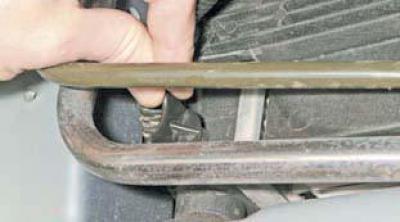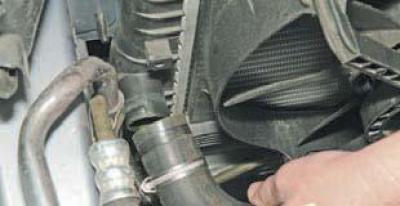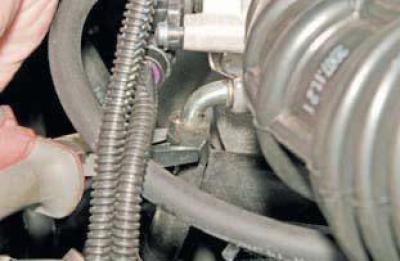If the engine is hot, let it cool down, and then relieve excess pressure in the cooling system by unscrewing the expansion tank cap.
We substitute a wide container with a volume of at least 7.5 liters under the drain hole made in the lower part of the left tank of the radiator of the cooling system.
To reduce the intensity of draining the liquid at the initial moment, the cap of the expansion tank should be tightly wrapped.

Loosen the radiator drain plug by hand..
... and drain the coolant into a container by unscrewing the expansion tank cap.
Loosen the lower radiator hose clamp with a Phillips screwdriver.

Remove the hose from the radiator hose..
... and drain the liquid from the engine into a substituted container.
To improve fluid drainage from the engine..

... with pliers, we compress the clamp that fastens the coolant supply hose to the throttle assembly heating unit and slide the clamp along the hose.
Remove the hose from the nozzle of the throttle assembly.
After draining the coolant, connect the hose to the radiator, tighten the clamp and wrap the radiator drain plug. We fill the system through the expansion tank until liquid flows from the coolant supply hose to the throttle assembly heating unit. After that, we install the hose in place and fix it with a clamp. Let's start the engine. With the engine running, we vigorously squeeze the cooling system hoses several times alternately - this will help the fluid fill the system and force air out of it. As the liquid level in the expansion tank drops, we bring it to normal and wrap the tank cap. When the engine warms up, the outlet (lower) the radiator hose should be cold for some time, and then heat up quickly, which will indicate the beginning of the circulation of fluid in a large circle. After waiting for the cooling fan to turn on, we stop the engine.
After the engine has cooled down, check the coolant level in the reservoir and top it up (it must be between the MIN and MAX marks).
